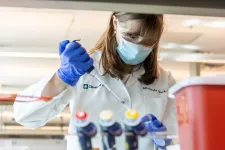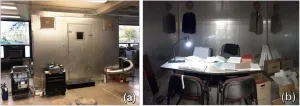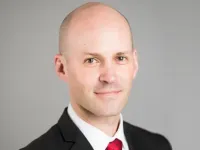(Press-News.org) Vision impairment is a pervasive problem facing nearly 2.2 billion people globally, according to the World Health Organization. But help is on the way: Neuroscientists are working at the cutting edge of technology and brain science to develop new ways for the vision impaired to navigate the world around them. At the annual meeting of the Cognitive Neuroscience Society (CNS), researchers are presenting new techniques for integrating digital haptics and sound technology to transform vision rehabilitation for both children and adults alike.
"Vision rehabilitation requires bridging fundamental research, modelling and neuroimaging methods," says Benedetta Franceschiello of the University of Lausanne, who is chairing the symposium on vision rehabilitation at CNS 2021 virtual. The new wave of devices to help the vision impaired combine these areas to deliver more personalized, democratized technological solutions. "We have cutting-edge analysis techniques, the computational power of supercomputers, the ability to record data to a level of detail that was not possible before, and the ability to create increasingly sophisticated and portable rehabilitation devices," she says.
At the same time, neuroscientists have great insight into the brain's plasticity and how the brain integrates information from multiple senses. "This field is developing at a fast rate, which is vital," says Ruxandra Tivadar of the University of Bern, "as having reduced or a lacking sensory function is an extremely grave impairment that impacts everyday function and thus the quality of life."
Tivadar is presenting new research showing how feedback from digital haptics - using the sense of touch coupled with motion - enables the visually impaired to easily learn about new objects and spaces. It's just one way researchers are leveraging all the human senses to develop new technology for vision rehabilitation.
Putting a finger on the problem
Teaching a visually impaired person how to navigate a new space is a tedious process, Tivadar says. "We need occupational therapists, we need to make tactile maps with different textures and, especially, for different places, and then we have to actually train the individual on tactile exploration before training them on the street," she explains. "Imagine future mobile phones with digital haptic feedback that allow the visually impaired to learn about new spaces instantly."
That is the future Tivadar is working toward, and with new results being presented at CNS, she and colleagues are showing it is possible, and, soon. In new unpublished research, Tivadar's team used digital haptics to represent the layout of an apartment in 2-D. Sighted participants who were blindfolded learned the layout by exploring a digital haptic rendering of the layout. They then had to actually navigate and complete tasks in the real, physical space that was previously unknown to them.
"Our data show that people learn these layouts well after only 45 minutes of training," Tivadar says. "In addition, we also see that participants have absolutely no problem in learning easy trajectories in this layout; all of our participants succeed at this task, whether previously trained or not."
The data also suggest that those participants who trained for harder navigation succeeded better than participants who were only trained on easier trajectories. "These findings imply that for really simple layouts, people need minimal training to succeed at imagining a space in their minds and then physically navigating it," Tivadar says.
Advances in big data analysis helped make this work possible. The researchers filmed the hands of 25 participants while they were exploring a haptic tablet for 8 to 10 minutes at a time. Tivadar's team then used a deep neural network to analyze the roughly 200 videos, using an algorithm that learns to track the movement of a single finger of each participant. "This enabled us to understand better how participants interact with haptics and to help further develop applications of this technology," Tivadar says. "Imagine if we can 'see' objects and spaces using one finger, what we could do by using all 10 of our fingers, or our whole palm to feel."
Tivadar's work integrating haptic data was born out of years researching sensory perception - looking not only at the sense of touch but also at auditory information. "Really, we study the ways in which people can see better using information from other senses," she says. "In neuroscience, this means looking at how the brain constructs visual images and trying to help the brain by augmenting or supplementing the information that it uses to construct these images. I think that merely the fact that we can do this is absolutely fascinating, and very promising for rehabilitation."
A sound solution for children
Millions of children globally live without sight, and their impairment can lead to manifold motor, perceptive, and social challenges. "Blind children have a lot of perceptual and social delays," says Monica Gori of the Italian Institute of Technology. "For example, sighted children learn to reach objects at 5 months. In blind children, this ability is significantly delayed and develops at one year of age. This delay produces a whole host of additional delays in movement and interaction with others that rehabilitators face every day."
A new multisensory rehabilitation device called ABBI is offering a new solution. In new work being presented at CNS, Gori and colleagues are working to identify the critical periods best suited for intervention with this device - to help blind children by 1 year of age.
Previous research had shown that the development of multisensory integration occurs late, after 8-10 years of age. "This discovery changed the way people think about the development of multisensory skills," Gori says. It provided her team the opportunity to develop an intervention that could help both visually impaired children and adults by integrating audio and motor information.
The ABBI device is a bracelet that they developed to use sound data in absence of visual data to help restore a sense of space. In a study looking at 3 months of training, visually impaired children between 6 and 15 years of age using the bracelet showed significant improvements in space representation and social skills. Those results have spurred the new follow-up study in children even younger.
"I am excited by the possibility of making early interventions and helping children develop perceptual and social skills," Gori says. "I believe that multisensory technologies, perhaps combined with sensory substitution devices, could bring significant benefits."
Gori's and Tivadar's technologies, along with the other work featured in the CNS symposium, offer glimpses of a promising future for vision rehabilitation - one not only informed by the latest in neuroscience but also driven by the need for low-cost solutions accessible to a wider population.
Says Tivadar: "We are able to do better visual rehabilitation when incorporating new technologies and using the brain's properties, such as multisensory integration and cross-modal plasticity. We need to look further into how our senses can complement or supplement each other in order to find low-cost solutions to vision rehabilitation."
INFORMATION:
The symposium "New Frontiers and technologies in Vision Rehabilitation" is taking place at 2pmET on Tuesday, March 16, 2021 as part of the CNS 2021 Virtual, from March 13-16.
CNS is committed to the development of mind and brain research aimed at investigating the psychological, computational, and neuroscientific bases of cognition. Since its founding in 1994, the Society has been dedicated to bringing its 2,000 members worldwide the latest research to facilitate public, professional, and scientific discourse.
FAIRFAX, Va. (March 16, 2021)--Many women suffering significant postpartum bleeding continue to receive hysterectomies, rather than uterine artery embolization (UAE), despite evidence that UAE results in reduced hospital stays and costs, and offers an opportunity to preserve fertility, according to new research to be presented at the Society of Interventional Radiology Annual Scientific Meeting.
"Giving birth has become increasingly dangerous for women in the U.S., and postpartum hemorrhage is a leading cause of the loss of life related to childbirth," said Janice M. Newsome, MD, FSIR, associate professor, Department of Radiology and Imaging ...
FAIRFAX, Va. (March 16, 2021)-- A minimally invasive treatment for patients whose cancer has spread to their bones provides quick and sustained pain relief and improves quality of life, according to a new study to be presented at the Society of Interventional Radiology Annual Scientific Meeting. The palliative treatment known as radiofrequency ablation (RFA) is effective in providing relief in as little as three days, and the benefits last more than 12 months--a significant improvement over radiation treatment.
"Commonly used radiation treatments can take weeks to provide pain relief," said Jason R. Levy, MD, a vascular and interventional radiologist at Northside Hospital in Atlanta and ...
FAIRFAX, Va. (March 16, 2021)-- A non-surgical treatment for arthritis in the knee is safe and effective in providing immediate and long-term pain relief, according to a new study to be presented at the Society of Interventional Radiology Annual Scientific Meeting. Genicular artery embolization (GAE) reduces inflammation in the knee to improve function and quality of life for people with moderate to severe knee pain. Osteoarthritis is one of most common causes of disability, limiting daily activities of 40% of all U.S. adults.
"Prior to treatment, patients' knee pain had taken over their whole life," said Siddharth A. Padia, MD, FSIR, professor of radiology, UCLA Health, and lead researcher of the study. ...
In an analysis that explores the structural underpinnings of a SARS-CoV-2 strain, G614, that quickly became dominant early in the pandemic, researchers discovered interactions that prevent this strain's spike from shedding its host binding domain too early. This may explain the enhanced infectivity of the G614 virus, they say. Throughout the COVID-19 pandemic, epidemiologists have monitored evolution of the SARS-CoV-2 virus with particular focus on the spike (S) protein. Spike trimers decorate the viral surface and facilitate host cell entry. An early variant with a single-residue substitution ...
March 16, 2021, PORT ST. LUCIE, FL: Researchers from Cleveland Clinic's Florida Research and Innovation Center (FRIC) have identified a potential new target for anti-COVID-19 therapies. Their findings were published in Nature Microbiology.
Led by FRIC scientific director Michaela Gack, Ph.D., the team discovered that a coronavirus enzyme called PLpro (papain-like protease) blocks the body's immune response to the infection. More research is necessary, but the findings suggest that therapeutics that inhibit the enzyme may help treat COVID-19.
"SARS-CoV-2 - the virus that causes COVID-19 - has evolved quickly against many of the body's well-known ...
The storms, which consist of brightenings and broadenings of the dawn flank of an oval of auroral activity that encircles Jupiter's poles, evolve in a pattern surprisingly reminiscent of familiar surges in the aurora that undulate across Earth's polar skies, called auroral substorms, according to the authors.
The new study is the first to track the storms from their birth on the nightside of the giant planet through their full evolution. It was published today in AGU Advances, AGU's journal for high-impact, short-format reports with immediate implications spanning all Earth and space sciences.
During a dawn storm, Jupiter's quiet and regular auroral arc transforms into a complex and intensely bright auroral ...
The market for air purifiers is booming, but a new study has found that some air cleaning technologies marketed for COVID-19 may be ineffective and have unintended health consequences.
The study, authored by researchers at Illinois Tech, Portland State University, and Colorado State University, found that cleaning up one harmful air pollutant can create a suite of others.
Both chamber and field tests found that an ionizing device led to a decrease in some volatile organic compounds (VOCs) including xylenes, but an increase in others, most prominently oxygenated VOCs (e.g., acetone, ethanol) and toluene, substances commonly found in paints, ...
Those who have persistent trouble sleeping may have an especially difficult grieving process after the death of a loved one, a new study co-authored by a University of Arizona researcher finds.
Most people who lose a close friend or family member will experience sleep troubles as part of the grieving process, as the body and mind react to the stress of the event, said study co-author Mary-Frances O'Connor, a professor in the UArizona Department of Psychology.
But O'Connor and her collaborators found that those who had persistent sleep challenges before losing someone were at higher risk for developing complicated grief after a loss. Complicated grief is characterized by a yearning for a lost loved one ...
It would surprise no one that pursuing a graduate degree can be a stressful endeavor, and for students who are transgender and nonbinary (TNB), the atmosphere can become toxic, according to University of Houston researcher Nathan Grant Smith. In a new paper published in Higher Education, Smith provides an analysis of current literature pertaining to TNB graduate student experiences and suggests interventions in graduate education to create more supportive environments for TNB students.
"Nearly 50% of graduate students report experiencing emotional or psychological distress during their enrollment in graduate school. Levels of distress are particularly high for transgender ...
It has long been understood that a parent's DNA is the principal determinant of health and disease in offspring. Yet inheritance via DNA is only part of the story; a father's lifestyle such as diet, being overweight and stress levels have been linked to health consequences for his offspring. This occurs through the epigenome - heritable biochemical marks associated with the DNA and proteins that bind it. But how the information is transmitted at fertilization along with the exact mechanisms and molecules in sperm that are involved in this process has been unclear until now.
A new study from McGill, published recently in Developmental Cell, has made a significant advance in the field by identifying how environmental information is transmitted by ...


